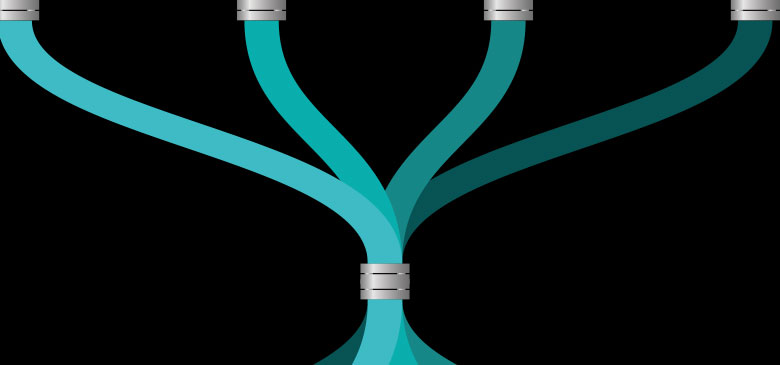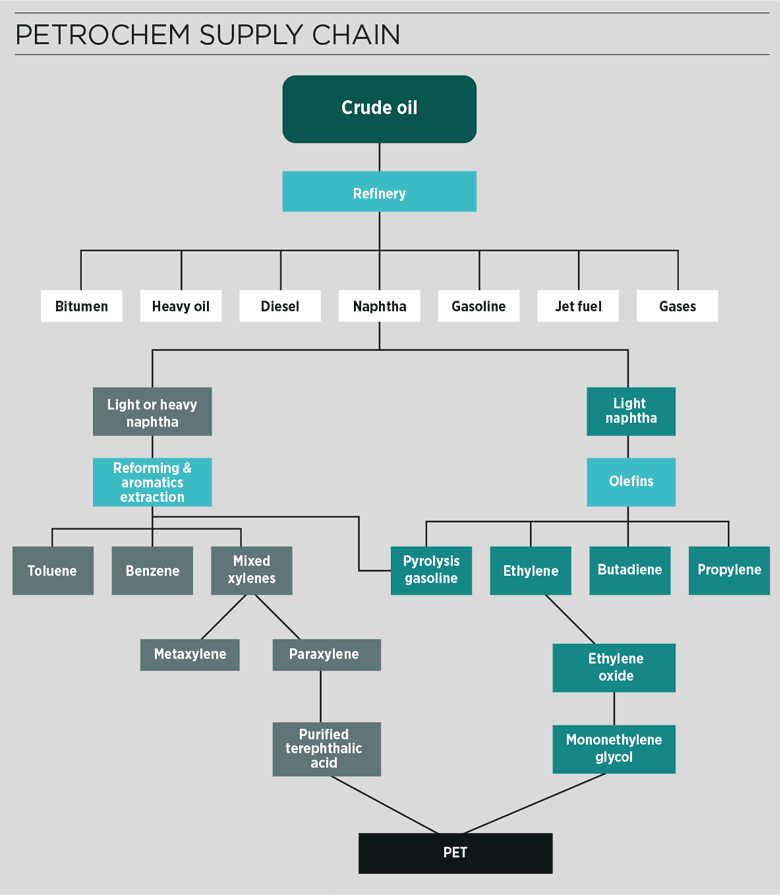
As a parent, there comes a stage in life where our children ask us the question we’ve always dreaded, but know will be innocently asked: “Daddy, where does polyethylene terephthalate (PET) come from and why would this concern a corporate treasurer?” A good question, my commodities-watching prodigy – and a testing one.
The petrochemical chain is one of the most elaborate and interconnected in the commodities world, and there are good reasons for treasurers to get to grips with its main features.
Firstly, there is a common misconception among some of the more casual commodities observers that the pricing of petrochemical products is entirely linked to the price of crude oil. If only life was so simple. The petrochem supply chain is complex and the determinant of pricing at each link in the chain, for both inputs and outputs, is also affected by supply and demand constraints and surpluses. Each link has its own microeconomic dynamics.
Secondly, the chain reacts differently to input prices, depending on the rate of change in prices and, ultimately, rate of change in the price of crude. In other words, there is no constant correlation between feedstock prices and crude oil, but, in essence, a variable correlation. This makes finding a market hedge for the various petrochemical products near impossible.
Generally, the faster the rate of change in crude oil prices, the greater the correlation of prices down the chain. For example, when the price of crude falls rapidly, as it is did in Q4 2014, then feedstock prices of paraxylene (PX) and purified terephthalic acid (PTA) and, ultimately, PET prices, all moved in around a 98-99% correlation to crude. The normal correlation is around 60%.
First of all, let’s look at the petrochem chain in more detail. Crude oil is extracted and transported to the refinery. Of the refinery’s output, over 90% is gasoline and other fuel products (such as diesel, fuel oil, aviation fuel), plus gases, coke and asphalt with well below 10% used for petrochemical feedstock. So, petrochem products aren’t really at the heart and soul of the refiner’s business.
Hence, if demand for fuel, in particular gasoline, goes down, then the refinery may reduce production and that can drive a fall in oil prices. So, even if demand for products at the end of the petrochem process, such as plastics and synthetics, doesn’t decline, the availability of the raw material goes down. Therefore, prices of petrochem feedstocks can go up, while oil is coming down.

Another feature of the chain is that feedstock can be used for different products. The next stage of the process is for the petrochem feedstock, mainly heavy naphtha, to go into the reformate pool, and then on to aromatics separation. Aromatics (not as attractive as they sound) are chemicals derived by two routes: (1) The high temperature ‘steam cracking’ of heavy or light naphtha; and (2) The ‘catalytic reforming’ of heavy naphtha. Separation yields the stable molecules of toluene, benzene and mixed xylenes.
Which of those three chemicals is produced depends on which can be more easily sold or commands a better price and margin. Benzene is used to produce polystyrene and nylon. So the more demand or better prices for benzene, then the less availability of mixed xylenes, which will then start to push the price of mixed xylenes back up. The mixed xylenes lead to the main feedstock for my PET.
Tracking the mixed xylenes downstream, now we have the price of crude oil, demand for gasoline and relative pricing of the aromatics to contend with. The mixed xylenes are now split into PX and metaxylene (MX). PX is then used to manufacture the main feedstock for PET, which is PTA.
Generally, the petrochem supply chain prices on a ‘cost plus’ basis, with the cost being the feedstock price and the plus being the conversion cost and profit margin. The lower a producer can keep their conversion costs, the higher the profit element.
The economics work so that the plus is the marginal cost of production of the last, and usually highest, cost supplier to satisfy demand. For example, let’s say productive capacity around the world for a particular chemical is two million metric tonnes (MT) per month, the cost per tonne of its feedstock is $600/MT and the delivered, direct, cash-conversion cost ranges from $50/MT for the most efficient producer to $200/MT for the least efficient with all producers on a sliding scale.
If demand is 1.6MT/month, then the market will buy its marginal MT at a conversion cost of $160/MT. That means the most efficient producer makes a profit of $110/MT, the marginal producer breaks even and the least efficient producers either don’t make anything or produce at a loss of up to $40/MT.
If you notice, the conversion cost referred to is only the direct cost of production and the logistics cost. This is because as long as the price at least covers the direct cost and makes a contribution to overheads, then it is worth producing, ie produce until marginal cost equals marginal revenue.
The faster the rate of change in crude oil prices, the greater the correlation of prices down the chain
Of course, as industry use starts to approach 100%, the price goes up. That sales price is the next player in the chain’s purchase price. So what happens if PX, for example, has limited production capacity, but PTA has a lot of capacity? Well, the model holds true. The PX producers will make good money through scarcity of demand and pricing at the cost of the highest cost producer, whereas the PTA output will price at the cost of one of the lower cost producers.
Notice the price of crude has little impact. That was someone’s input cost higher up, but now I’m faced with production and supply constraints or surpluses, competing uses for feedstocks and relative costs of peer group producers. Of course, when the price of crude hits the news, everyone along the supply chain wakes up and either rushes to buy, offering good prices to buy now (a classic inflationary market) or realises there’s no need to buy now or pay today’s prices because costs and prices will soon come down (a classic deflationary market).
So how do I, as a treasurer, manage this? The first stop is, as always, the natural hedge. Make sure there is no timing difference between the time raw materials are priced and the time PET is priced. In terms of currency risk, I do have the benefit that the petrochem supply chain, outside the EU, is denominated in $, so the vast bulk of my sales and purchases are in $, with only minor exposures to € and £.
On top of commodity and currency risk, I also have liquidity. The petrochem supply chain is not just lengthy in the number of links, but also in terms of physical distance and time. Oil goes from the oilfield, say, in Saudi Arabia, to a refinery, which is best placed close to its primary market, say, China. The refinery carries out aromatics separation through to PX and PTA, and perhaps supplies customers in Korea.
Then, the PTA is shipped to me in Oman, turned into PET and shipped to a packager or preformer in California, where it is then converted into packaging before going to a packager in Mexico, from where it is shipped to Tesco in Warrington, where my wife buys it, puts it in the fruit bowl, chucking the packaging in the recycling bin two minutes later.
That whole chain (including the last two minutes) can take between 12 to 18 months. Nobody wants to pay before they’ve got their money and nobody wants to take credit risk, so letters of credit (LCs) of up to 180 days stretch along the chain. That is apart from the last parts of the journey after Oman, where suppliers and customers usually operate on (credit-insured) open account.
A final piece of advice would be to be aware of the liquidity risk and the need for very sizeable non-funded (usance or sight) LC facilities.
Gary Slawther is financing adviser to the CEO of Octal and is based in Oman
